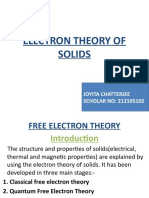Band Theory of Solids
Band Theory of Solids
Uploaded by
Mohammad Gulam AhamadCopyright:
Available Formats
Band Theory of Solids
Band Theory of Solids
Uploaded by
Mohammad Gulam AhamadOriginal Description:
Original Title
Copyright
Available Formats
Share this document
Did you find this document useful?
Is this content inappropriate?
Copyright:
Available Formats
Band Theory of Solids
Band Theory of Solids
Uploaded by
Mohammad Gulam AhamadCopyright:
Available Formats
Band Theory of Solids
(Garcia Chapter 24)
Electrons in Solids
Considering electrons in metals as free
particles, electron gas in a box explains
many experimental results which?
Still, why are some solids metals and others
insulators?
For metals we assumed that electrons are free
We know, however, that there are no free
electrons in insulators
QM give us the answer!
Need a more realistic potential for electrons
reflecting periodic ionic structure of solids
Realistic Potential in Solids
n
i
are integers
Example: 2D Lattice
c n b n a n T
T r U r U
3 2 1
) ( ) (
+ + =
+ =
3 ; 2
2 1
2 1
= =
+ =
n n
b n a n T
Realistic Potential in Solids
For one dimensional case where atoms (ions)
are separated by distance d, we can write
condition of periodicity as
) ( ) ( n d x U x U + =
Realistic Potential in Solids
Multi-electron atomic potentials are complex
Even for hydrogen atom with a simple
Coulomb potential solutions are quite
complex
So we use a model one-dimensional periodic
potential to get insight into the problem
Blochs Theorem
Blochs Theorem states that for a particle
moving in the periodic potential, the
wavefunctions (x) are of the form
u
k
(x) is a periodic function with the periodicity
of the potential
The exact form depends on the potential
associated with atoms (ions) that form the solid
) ( ) (
function periodic a is ) ( , ) ( ) (
d x u x u
x u where e x u x
k k
k
ikx
k
+ =
=
Blochs Theorem
Blochs Theorem imposes very special
conditions on any solution of the
Schrdinger equation, independent of the
form of the periodic potential
The wave vector k has a two-fold role:
1. It is still a wave vector in the plane wave part of
the solution
2. It is also an index to u
k
(x) because it contains all
the quantum numbers, which enumerate the
wavefunction
Blochs Theorem
What is probability density of finding
particle at coordinate x?
2
* *
*
*
2
) ( ) (
) ( ) ( ) ( ) ( ) (
] ) ( [ ] ) ( [ ) (
) ( ) ( ) ( ) (
x u x P
x u x u e e x u x u x P
e x u e x u x P
x x x x P
k
k k
ikx ikx
k k
ikx
k
ikx
k
=
= =
=
= =
But |u
k
(x)|
2
is periodic, so P(x) is as well
2
) (x u
k
Blochs Theorem
The probability of finding an electron at
any atom in the solid is the same!!!
Each electron in a crystalline solid
belongs to each and every atom
forming the solid
) ( ) ( d x P x P + =
Covalent Bonding Revisited
When atoms are covalently bonded
electrons supplied by atoms are
shared by these atoms since pull of
each atom is the same or nearly so
H
2
, F
2
, CO,
Example: the ground state of the
hydrogen atoms forming a molecule
If the atoms are far apart there is very
little overlap between their wavefunctions
If atoms are brought together the
wavefunctions overlap and form the
compound wavefunction,
1
(r)+
2
(r),
increasing the probability for electrons to
exist between the atoms
0
/
3
0
1
1
a r
s
e
a
=
t
Covalent Bonding Revisited
Schrdinger Equation Revisited
If a wavefunctions
1
(x) and
2
(x) are
solutions for the Schrdinger equation for
energy E, then functions
-
1
(x), -
2
(x), and
1
(x)
2
(x) are also solutions
of this equations
the probability density of -
1
(x) is the same as for
1
(x)
)] ( ) ( [ )] ( ) ( )[ (
)] ( ) ( [
2
) ( )] ( )[ (
) (
2
2 1 2 1
2
2 1
2 2
2 , 1 2 , 1
2
2 , 1
2
2
x x E x x x U
dx
x x d
m
x E x x U
dx
x d
m
+ = + +
+
= +
Consider an atom with only one electron in s-state
outside of a closed shell
Both of the wavefunctions below are valid and the
choice of each is equivalent
If the atoms are far apart, as before, the
wavefunctions are the same as for the isolated
atoms
Band Theory of Solids
0
0
/
/
) ( ) (
) ( ) (
na Zr
s
na Zr
s
e r Af r
e r Af r
+
=
+ =
Band Theory of Solids
The sum of them is shown in the
figure
These two possible combinations
represent two possible states of
two atoms system with different
energies
Once the atoms are brought together the
wavefunctions begin to overlap
There are two possibilities
1. Overlapping wavefunctions are the same (e.g.,
s
+
(r))
2. Overlapping wavefunctions are different
Tight-Binding Band Theory
of Solids
Garcia Chapter 24.4 and 24.5
Electron in Two Separated Potential Wells
Potential Wells Moved Closer
Tight-Binding Approximation
first two states in infinite and finite potential
wells
Symmetric and Anti-symmetric
Combinations of Ground State
Eigenfunctions
Six States for Six Atom Solid
Splitting of 1s State of Six Atoms
Atoms and Band Structure
Consider multi-electron atoms:
1. The outer electrons (large n and l)
are closer to each other than the
inner electrons
Thus, the overlap of the wave-
functions of the outer electrons is
stronger than overlap of those of
inner electrons
Therefore, the bands formed from
outer electrons are wider than the
bands formed from inner electrons
Bands with higher energies
are therefore wider!
Splitting of Atomic Levels in Sodium
Occupation of Bands Sodium
Splitting of Atomic Levels in Carbon
Occupation in Carbon at Large
Atomic Separation
Actual Occupation of Energy bands
in Diamond
Insulators, Semiconductors,
Metals
The last completely filled (at least at T = 0 K)
band is called the Valence Band
The next band with higher energy is the
Conduction Band
The Conduction Band can be empty or partially
filed
The energy difference between the bottom of
the CB and the top of the VB is called the
Band Gap (or Forbidden Gap)
Can be found using computer
In 1D computer simulation of light in a
periodic structure, we found the
frequencies and wave functions
Allowed modes fall into quasi-
continuous bands separated by forbidden
bands just as would be expected from the
tight binding model
Computer simulation can give
exact solution in simple cases
Insulators, Semiconductors,
Metals
Consider a solid with the empty
Conduction Band
If apply electric field
to this solid, the
electrons in the
valence band (VB)
cannot participate in
transport (no current)
Insulators, Semiconductors,
Metals
The electrons in the VB do not
participate in the current, since
Classically, electrons in the
electric field accelerate, so they
acquire [kinetic] energy
In QM this means they must
acquire slightly higher energy
and jump to another quantum
state
Such states must be available,
i.e. empty allowed states
But no such state are available in
the VB!
This solid
would behave
as an insulator
Insulators, Semiconductors,
Metals
Consider a solid with the half filled
Conduction Band (T = 0K)
If an electric field is applied
to this solid, electrons in the
CB do participate in
transport, since there are
plenty of empty allowed
states with energies just
above the Fermi energy
This solid would behave as
a conductor (metal)
Band Overlap
Many materials are
conductors (metals) due to the
band overlap phenomenon
Often the higher energy bands
become so wide that they
overlap with the lower bands
additional electron energy levels
are then available
Band Overlap
Example: Magnesium (Mg; Z =12): 1s
2
2s
2
2p
6
3s
2
Might expect to be insulator; however, it is a metal
3s-band overlaps the 3p-band, so now the
conduction band contains 8N energy levels, while
only have 2N electrons
Other examples: Zn, Be, Ca, Bi
Band Hybridization
In some cases the opposite occurs
Due to the overlap, electrons from different shells
form hybrid bands, which can be separated in
energy
Depending on the magnitude of the gap, solids
can be insulators (Diamond); semiconductors (Si,
Ge, Sn; metals (Pb)
Insulators, Semiconductors, Metals
There is a qualitative difference between
metals and insulators (semiconductors)
the highest energy band containing electrons is
only partially filled for Metals (sometimes due to
the overlap)
Thus they are good conductors even at very low
temperatures
The resisitvity arises from the electron scattering from
lattice vibrations and lattice defects
Vibrations increases with temperature higher
resistivity
The concentration of carriers does not change
appreciably with temperature
Insulators, Semiconductors, Metals
The difference between Insulators and
Semiconductors is quantitative
The difference in the magnitude of the band gap
Semiconductors are Insulators with a
relatively small band gap
At high enough temperatures a fraction of electrons
can be found in the conduction band and therefore
participate in transport
Insulators vs Semiconductors
There is no difference between Insulators and
Semiconductors at very low temperatures
In neither material are there any electrons in the
conduction band and so conductivity vanishes in
the low temperature limit
Insulators vs Semiconductors
Differences arises at high temperatures
A small fraction of the electrons is thermally
excited into the conduction band. These
electrons carry current just as in metals
The smaller the gap the more electrons in the
conduction band at a given temperature
Resistivity decreases with temperature due to
higher concentration of electrons in the
conduction band
*
2
1
m
n q t
o
= =
Holes
Consider an insulator (or semiconductor)
with a few electrons excited from the valence
band into the conduction band
Apply an electric field
Now electrons in the valence band have some
energy sates into which they can move
The movement is complicated since it involves
~ 10
23
electrons
Concept of Holes
Consider a semiconductor with a small number of
electrons excited from the valence band into the
conduction band
If an electric field is applied,
the conduction band electrons will participate in the
electrical current
the valence band electrons can move into the empty
states, and thus can also contribute to the current
Holes from the Band Structure
Point of View
If we describe such changes via
movement of the empty states the
picture can be significantly simplified
This empty space is a Hole
Deficiency of negative charge holes are
positively charged
Holes often have a larger effective mass
(heavier) than electrons since they represent
collective behavior of many electrons
Holes
We can replace electrons at the top of eth
band which have negative mass (and
travel in opposite to the normal direction)
by positively charged particles with a
positive mass, and consider all phenomena
using such particles
Such particles are called Holes
Holes are positively charged and move in
the same direction as electrons they
replace
Hole Conduction
To understand hole motion, one requires
another view of the holes, which represent
them as electrons with negative effective
mass
To imagine the movement of the hole think of
a row of chairs occupied by people with one
chair empty
To move all people rise all together and
move in one direction, so the empty spot
moves in the same direction
Concept of Holes
If we describe such changes via movement
of the empty states the picture will be
significantly simplified
This empty space is called a Hole
Deficiency of negative charge can be treated as
a positive charge
Holes act as charge carriers in the sense that
electrons from nearby sites can move into the
hole
Holes are usually heavier than electrons since
they depict collective behavior of many electrons
Conduction
Electrical current for holes and electrons in the same direction
You might also like
- Electron Theory of SolidsDocument18 pagesElectron Theory of SolidsJoyita100% (1)
- Structure and BondingDocument12 pagesStructure and BondingNisha JodhanNo ratings yet
- Band Theory of Solids: Christian Bergfjord & Selda EkizDocument44 pagesBand Theory of Solids: Christian Bergfjord & Selda EkizAzhar MahmoodNo ratings yet
- Mat Sci Slides 2Document29 pagesMat Sci Slides 2abcdNo ratings yet
- Band Theory of SolidsDocument2 pagesBand Theory of SolidsrekhajayarajanNo ratings yet
- Steady State Approximation: Supplementary Notes For The Course "Chemistry For Physicists"Document5 pagesSteady State Approximation: Supplementary Notes For The Course "Chemistry For Physicists"Rishav DugarNo ratings yet
- L2. Structure of MatterDocument11 pagesL2. Structure of MatterNourhan IbrahimNo ratings yet
- Kirkendal Effect Paper PDFDocument4 pagesKirkendal Effect Paper PDFAnonymous DmKpKA6wHNo ratings yet
- Chemical KineticsDocument69 pagesChemical KineticsDaniel YakubovichNo ratings yet
- Density of States - Derivation PDFDocument5 pagesDensity of States - Derivation PDFsarathsrnairNo ratings yet
- Introduction To Energy Band For EngineersDocument4 pagesIntroduction To Energy Band For EngineersDerbew Gahaw100% (1)
- Thin Film Technology An Introduction To DepositionDocument7 pagesThin Film Technology An Introduction To DepositionGeetha Sokkian RammanoharNo ratings yet
- Kirkendall Effect, Importance, and Theory, Its Use: HistoryDocument2 pagesKirkendall Effect, Importance, and Theory, Its Use: HistoryAbu HurairaNo ratings yet
- Electrical Properties of SolidsDocument54 pagesElectrical Properties of SolidsAnthonio MJNo ratings yet
- Interatomic Forces: What Kind of Force Holds The Atoms Together in A Solid?Document36 pagesInteratomic Forces: What Kind of Force Holds The Atoms Together in A Solid?aditya_2013No ratings yet
- Crystal DefectsDocument37 pagesCrystal DefectsMd Mehrab Alam ShayikhNo ratings yet
- Unit 5 - Engg Physics NEP Superconductors and NanoDocument9 pagesUnit 5 - Engg Physics NEP Superconductors and NanojanhvilkwNo ratings yet
- Solid State Physics2 PDFDocument72 pagesSolid State Physics2 PDFTejasree KambamNo ratings yet
- Superconductivity (New)Document9 pagesSuperconductivity (New)RshshNo ratings yet
- Band Theory of Solids: Brajesh Tiwari and R. E. AmritkarDocument9 pagesBand Theory of Solids: Brajesh Tiwari and R. E. AmritkarkapilNo ratings yet
- Band GapDocument13 pagesBand Gapit rewaNo ratings yet
- Raman SpectraDocument29 pagesRaman SpectraPramendra YadavNo ratings yet
- Solid State PhysicsDocument9 pagesSolid State Physicssjo05No ratings yet
- Unit 2 NotesDocument10 pagesUnit 2 NotesG.MUNEER BABA,EEE18 Vel Tech, ChennaiNo ratings yet
- Basic Concepts of Superconductivity-1Document9 pagesBasic Concepts of Superconductivity-1Srikanth BatnaNo ratings yet
- Imperfections in SolidsDocument10 pagesImperfections in Solidsshubhamgautam56_64970% (1)
- Redox SystemDocument21 pagesRedox SystemDesy KriswintariNo ratings yet
- Solid State - Point DefectDocument6 pagesSolid State - Point DefectSiddharth palNo ratings yet
- Introduction To MagnetochemistryDocument8 pagesIntroduction To MagnetochemistryMuhammad ZubairNo ratings yet
- Band Theory of SolidsDocument22 pagesBand Theory of Solidsmunku05100% (1)
- Energy Bands For Electrons in Crystals (Kittel Ch. 7)Document39 pagesEnergy Bands For Electrons in Crystals (Kittel Ch. 7)sabhanNo ratings yet
- Presentation1 090415045351 Phpapp01 - 2Document24 pagesPresentation1 090415045351 Phpapp01 - 2JitendraKumarNo ratings yet
- Lattice EnergiesDocument13 pagesLattice Energiessajalgiri0% (1)
- Wiedemann-Franz Law PDFDocument3 pagesWiedemann-Franz Law PDFArunraj KasiNo ratings yet
- Electrical Measurement Lab (EEE-352)Document23 pagesElectrical Measurement Lab (EEE-352)DhinakarrajNo ratings yet
- Thermal Properties of SolidsDocument16 pagesThermal Properties of SolidsParie Perdana100% (1)
- Bonds in SolidsDocument729 pagesBonds in Solids1553No ratings yet
- Cooper Pair 2Document9 pagesCooper Pair 2hamedaNo ratings yet
- MultiferroicsDocument21 pagesMultiferroicsprashantitbhushahi100% (3)
- Meissner EffectDocument3 pagesMeissner Effectsuba lakshmiNo ratings yet
- Magnetic Properties of SolidsDocument18 pagesMagnetic Properties of SolidsRamnayak Katravath100% (1)
- Ferroelectricity: Spontaneous Dipole MomentDocument24 pagesFerroelectricity: Spontaneous Dipole Momentaliazab100% (2)
- Lecture 10 - Optical Transitions in SemiconductorsDocument10 pagesLecture 10 - Optical Transitions in SemiconductorsarashmokhtariNo ratings yet
- Eme 1166 Materials Science: DiffusionDocument55 pagesEme 1166 Materials Science: DiffusionJONATHAN RAJ A/L SEMANNo ratings yet
- 2.1 The Structure of SolidsDocument22 pages2.1 The Structure of Solidsashleykingpalomo13No ratings yet
- Point Defects in SolidsDocument37 pagesPoint Defects in SolidsSachi SinghNo ratings yet
- Xxcaa (Rolf E. Hummel) Electronic Properties of MaterialDocument94 pagesXxcaa (Rolf E. Hummel) Electronic Properties of MaterialfonsekapdlNo ratings yet
- The Steady State Approximation Is A Method Used To Estimate The Overall Reaction Rate of A MultiDocument6 pagesThe Steady State Approximation Is A Method Used To Estimate The Overall Reaction Rate of A MultiMubashar ShakeelNo ratings yet
- MELC 7 Chemical Bonding 1Document32 pagesMELC 7 Chemical Bonding 1A Dee YoungNo ratings yet
- Chapter 2: X-Ray, Neutron, and Electron Diffraction in CrystalsDocument10 pagesChapter 2: X-Ray, Neutron, and Electron Diffraction in Crystalsnahom tefera100% (1)
- Advantages:: DisadvantagesDocument10 pagesAdvantages:: DisadvantagesZahir Rayhan JhonNo ratings yet
- Surface ChemistryDocument46 pagesSurface Chemistryyash guptaNo ratings yet
- What Are S, P, D, F Orbitals?Document6 pagesWhat Are S, P, D, F Orbitals?NelsonMoseMNo ratings yet
- Chapter 3c X Ray DiffractionDocument48 pagesChapter 3c X Ray DiffractionAnup Dalal100% (1)
- Characteristics Optical Physics in Solid State: Optical Properties of Solids BY Mark FoxDocument16 pagesCharacteristics Optical Physics in Solid State: Optical Properties of Solids BY Mark FoxMuhammad YaseenNo ratings yet
- 2-Crystal Symmetry and Classification-2Document7 pages2-Crystal Symmetry and Classification-2Cazimir BostanNo ratings yet
- Solid State Chemistry - EPMDocument8 pagesSolid State Chemistry - EPMjahidul islamNo ratings yet
- Band Theory of Solids: (Garcia Chapter 24)Document46 pagesBand Theory of Solids: (Garcia Chapter 24)hoangan_lyk12100% (1)
- Band Theory of Soids5!1!13Document20 pagesBand Theory of Soids5!1!13Ravi Kumar BanalaNo ratings yet
- Control Systems1Document19 pagesControl Systems1Mohammad Gulam AhamadNo ratings yet
- Control Systems1Document19 pagesControl Systems1Mohammad Gulam AhamadNo ratings yet
- Donors and Acceptors in SemiconductorsDocument28 pagesDonors and Acceptors in SemiconductorsMohammad Gulam AhamadNo ratings yet
- Examples OfzTransformDocument17 pagesExamples OfzTransformMohammad Gulam Ahamad100% (1)
- Distributed Systems Architectures: Architectural Design For Software That Executes On More Than One ProcessorDocument44 pagesDistributed Systems Architectures: Architectural Design For Software That Executes On More Than One ProcessorMohammad Gulam AhamadNo ratings yet
- Client Server and ProtocolsDocument18 pagesClient Server and ProtocolsMohammad Gulam AhamadNo ratings yet
- m6 GameDocument21 pagesm6 GameMohammad Gulam AhamadNo ratings yet
- Application of Image Enhancement Techniques To Magnetic Resonance ImagingDocument14 pagesApplication of Image Enhancement Techniques To Magnetic Resonance ImagingMohammad Gulam AhamadNo ratings yet
- IntrotocomputerDocument16 pagesIntrotocomputerMohammad Gulam AhamadNo ratings yet
- AIDocument9 pagesAIMohammad Gulam AhamadNo ratings yet
- Data Structures-TreesDocument40 pagesData Structures-TreesMohammad Gulam Ahamad100% (3)
- MPC555 IoDocument24 pagesMPC555 IoMohammad Gulam AhamadNo ratings yet
- PIC MicrocontrollersDocument20 pagesPIC MicrocontrollersMohammad Gulam Ahamad75% (4)
- Dr. Mohammed Gulam AhamadDocument37 pagesDr. Mohammed Gulam AhamadMohammad Gulam AhamadNo ratings yet
- MPC555Document27 pagesMPC555Mohammad Gulam AhamadNo ratings yet










































































